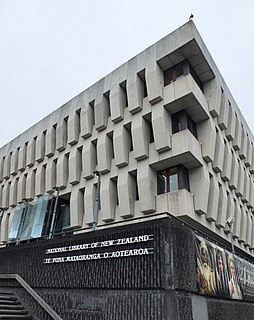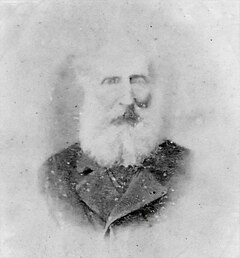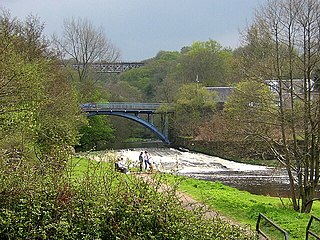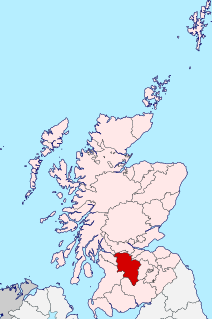
The National Library of New Zealand is New Zealand's legal deposit library charged with the obligation to "enrich the cultural and economic life of New Zealand and its interchanges with other nations". Under the Act, the library is also expected to be:

Ethan Allen Brown was a Democratic-Republican politician. He served as the seventh Governor of Ohio.

The New Zealand Herald is a daily newspaper published in Auckland, New Zealand, owned by New Zealand Media and Entertainment. It has the largest newspaper circulation of all newspapers in New Zealand, peaking at over 200,000 copies in 2006, although circulation of the daily Herald had declined to 115,213 copies on average by December 2017. Its main circulation area is the Auckland region. It is also delivered to much of the north of the North Island including Northland, Waikato and King Country.
Captain William Cornwallis Symonds was a British Army officer who was prominent in the early colonisation of New Zealand.

SY Aurora was a barque-rigged steam yacht built by Alexander Stephen and Sons Ltd. in Dundee, Scotland, in 1876, for the Dundee Seal and Whale Fishing Company. It was 165 feet (50 m) long with a 30-foot (9.1 m) beam. The hull was made of oak, sheathed with greenheart and lined with fir. The bow was a mass of solid wood reinforced with steel-plate armour. The heavy side frames were braced by two levels of horizontal oak beams. Her primary use was whaling in the northern seas, and she was built sturdily enough to withstand the heavy weather and ice that would be encountered there. That strength proved useful for Antarctic exploration as well and between 1911 and 1917 she made five trips to the continent, both for exploration and rescue missions.
The following lists events that happened during 1916 in New Zealand.
The following lists events that happened during 1917 in New Zealand.
The following lists events that happened during 1918 in New Zealand.
The following lists events that happened during 1921 in New Zealand.

The New Zealand fernbird or simply fernbird is an insectivorous bird endemic to New Zealand. The Māori names are kōtātā or mātātā.

New Zealand is a sovereign island country in the southwestern Pacific Ocean. The country geographically comprises two main landmasses—the North Island, and the South Island —and around 600 smaller islands. New Zealand is situated some 2,000 kilometres (1,200 mi) east of Australia across the Tasman Sea and roughly 1,000 kilometres (600 mi) south of the Pacific island areas of New Caledonia, Fiji, and Tonga. Because of its remoteness, it was one of the last lands to be settled by humans. During its long period of isolation, New Zealand developed a distinct biodiversity of animal, fungal, and plant life. The country's varied topography and its sharp mountain peaks, such as the Southern Alps, owe much to the tectonic uplift of land and volcanic eruptions. New Zealand's capital city is Wellington, while its most populous city is Auckland.
The following lists events that happened during 1838 in New Zealand.
Alfred Nesbit Brown was a member of the Church Missionary Society (CMS) and one of a number of missionaries who travelled to New Zealand in the early 19th century to bring Christianity to the Māori people.
The following lists events that happened during 1830 in New Zealand.
There is a lessening of the sealing rush at Bass Strait as the rookeries become thinner, and as a result sealers return to Dusky Sound and explore the surrounding coast. Little of the movements of these ships is actually recorded as a veil of secrecy still surrounds their activities while the various ships try to make the most of any discoveries before the competition arrives. They occasionally meet local Māori but little information regarding these encounters survives. There are again around half a dozen whalers off the north-east coast of New Zealand, a few of which call into the Bay of Islands. The first Māori to join a whaling ship, and possibly the first to leave New Zealand in 10 years, does so early in the year.
James Clark Brown was a 19th-century Member of Parliament in Otago, New Zealand.
The United States Senate elections of 1830 and 1831 were elections that had Jacksonians gain one seat in the United States Senate from the Anti-Jacksonian coalition, but lose one seat to the short-lived Nullifier Party. By the time Congress first met in December 1831, however, the Jacksonians had a net loss of one seat.
The 1854 City of Auckland by-election was a by-election held in the multi-member City of Auckland electorate on 4 August 1854 during the 1st New Zealand Parliament. It was one of the earliest by-elections in New Zealand political history and was triggered by the resignation of Thomas Bartley. Bartley resigned on 11 July 1854 to take up a place in the Legislative Council.
Events from the year 1830 in Scotland.

Peter Imlay (1797–1881), along with his brothers Alexander (1794-1847) and George (1794?-1846) were Scottish-born pioneer settlers in southern New South Wales. They operated in the region as pastoralists, whalers and shipbuilders.









